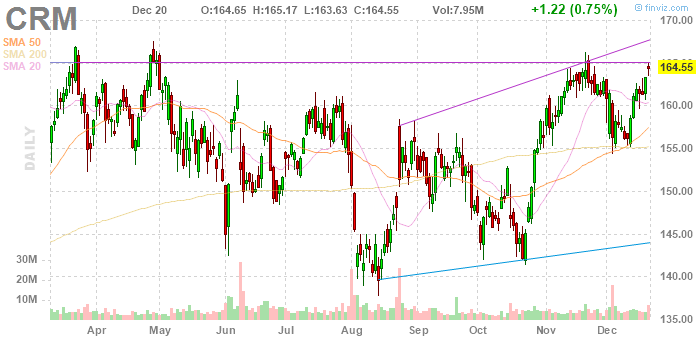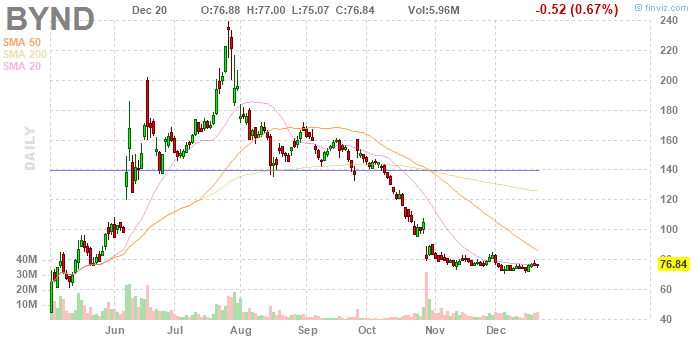Growth stocks have led the rally in U.S. stocks, a rally that now has lasted for over a decade. At the moment, it doesn’t seem like that will change.
After all, all three broad market indices closed Friday at all-time highs. Growth stocks did sell off earlier this year, with names like Shopify (NYSE:SHOP) and Roku (NASDAQ:ROKU) plummeting sharply. But for the most part, those losses reversed: SHOP stock, for instance, has moved back near all-time highs. ROKU did the same before a recent fade.
Monday’s big stock charts feature three growth stocks that have seen varying performance of late. But if category strength continues, all three could outperform in 2020.
Salesforce.com (CRM)
Salesforce (NYSE:CRM) has been here before — and as the first of Monday’s big stock charts shows, it hasn’t worked out well in the past. The question now is if this time will be different:
- Resistance has been firm at $165 for much of this year. Even back at October 2018 highs, CRM stock reversed after peaking just above $160. There’s not much reason to suggest another decline is imminent at the moment — but investors could have thought the same last month or in late April.
- Near-term trading in Salesforce stock seems potentially important for the category as a whole. I’ve long argued that CRM is an intriguing barometer for the market as a whole. There’s really not much debate about the quality of Salesforce’s business. Not even Microsoft (NASDAQ:MSFT), a competitor via its Dynamics platform, has been able to make a dent. For the most part, CRM stock is an argument over valuation, which makes it an interesting proxy for growth stocks on the whole.
- On that front, little has changed. Salesforce stock remains a long way from cheap, at 53x next year’s consensus earnings estimate. Those estimates don’t suggest much in the way of growth: just 7% year-over-year. If investors are willing to pay an even higher multiple for CRM, other high-valuation stocks can rally. If not, we might be approaching the limit to multiples across the market.
Beyond Meat (BYND)
Beyond Meat (NASDAQ:BYND) is starting to find a bottom. Shares touched a six-month low last Monday, but gained 7.2% over the rest of the week. The second of Monday’s big stock charts doesn’t necessarily suggest a rebound is imminent, but BYND at the least might be heading back toward normalcy:
- Technically, there is some good news here. BYND stock is tracking the 20-day moving average at the moment, which may revert from resistance to support. Volume in the last two months has increased, during which time share performance has improved. Again, there isn’t a bullish signal on the chart yet, but shares at the least are consolidating.
- Fundamentally, Beyond Meat stock is more interesting than it might seem. It’s obvious in retrospect that the rally to $200-plus was something close to a bubble. Shares hardly are cheap. But as I wrote last week, the company has a huge opportunity. And in many ways, BYND remains misunderstood. Its business model is based on modest adoption by traditional meat-eaters; not vegans and/or health-focused consumers. Those meat-eaters are driving what has been truly impressive growth: revenue has increased over 250% so far in 2019, with gains in both the grocery store channel and in restaurants.
- All that said, shares do trade hands at roughly 14x this year’s revenue. A rally is going to require a market still willing to pay up for growth — and even that may not be enough at these levels. But at the least, it seems like BYND is positioned for a rebound at some point in 2020, if it can keep delivering on its promise.
Under Armour (UA) (UAA)
Under Armour (NYSE:UA,NYSE:UAA) looked like a “busted growth” story just a month ago. Back-to-back disappointing earnings reports and an accounting investigation sent UAA stock to a ten-month low. But shares have roared of late. The third of Monday’s big stock charts suggests the stock could be at an inflection point:
- Under Armour stock already has broken out. With the stock at resistance that has held going back to September, the question is if the breakout will continue, particularly with the 200-day moving average providing another roadblock to clear. If UAA can get past $20, the chart strongly suggests it can keep rallying and even challenge this summer’s highs.
- From here, such a rally looks questionable from a fundamental standpoint. I’ve long been bearish on UAA stock. If anything, the recent earnings reports seem to support the bear case, and a lower share price. But the stock has managed to defy gravity in the past, and there’s still an argument that the company can resurrect growth and protect margins, particularly with a much-needed management change.
- Here, too, market sentiment seems key. Growth stock investors are looking for opportunities where they can find them, and a potential turnaround here might be more attractive in a market where quality names are pricing in something close to perfection already. If companies performing better are available at a more reasonable price, those investors might be less willing to give UAA the benefit of the doubt.
As of this writing, Vince Martin has no positions in any securities mentioned.



